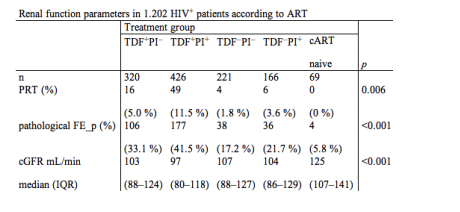 |
 |
 |
| |
Tenofovir and PI Use Are Associated with an Increased Prevalence of Proximal Renal Tubular Dysfunction in the Swiss HIV Cohort Study: boosted PI+TDF associated with renal function
|
| |
| |
Christoph Fux*1, M Opravil2, M Cavassini3, A Calmy4, M Flepp5, V Gurtner-Delafuente6, M Stoeckle7, P Schmid8, A Rauch1, H Furrer1, and Swiss HIV Cohort Study (SHCS)
1Univ Hosp Bern, Switzerland; 2Univ Hosp Zurich, Switzerland; 3Ctr Hosp Univ Vaudois, Lausanna, Switzerland; 4Univ Hosp Geneva, Switzerland; 5Klinik im Park, Zurich, Switzerland; 6Civic Hosp, Lugano, Switzerland; 7Univ Hosp Basel, Switzerland; and 8Cantonal Hosp, St Gallen, Switzerland
Background: Tenofovir (TDF) use has been associated with proximal renal tubulopathy (PRT). Excessive renal phosphate losses are of particular concern, as they may induce compensatory bone resorption and thus osteoporosis. The prevalence of PRT and risk factors associated with PRT are unknown.
Methods: We performed a cross-sectional analysis of proximal renal tubular function measuring the fractional excretions of phosphate (FE_p) and uric acid, the urine protein/creatinine ratio, and euglycemic glucosuria. PRT was defined as ≥3 of 4 pathological parameters. A FE_p >20% (>10% if hypophosphatemic) was considered pathological. Logistic regression analyses were performed to identify associated risk factors.
Results: We included 1202 consecutive patients (73% males, 14% intravenous drug users [IDU], 27% CDC-stage C, 5.7% treatment-naive) with a median 45 (IQR 40 to 52) years of age and 11 (5 to 16) years of HIV infection. The median CD4 count was 479 (342 to 650) cells/mL; 90% of cART-treated patients were virologically suppressed. Compared to TDF- and PI-sparing cART, the prevalence of PRT and a pathological FE_p was higher in TDF-treated individuals (p = 0.06 and p <0.001, respectively) and highest (11.5% and 41.5%) in patients under combined TDF/PI treatment (p <0.001 each; see table). In multivariable logistic regression the use of TDF (OR 3.3, 95%CI 1.6 to 7.0), PI (1.8, 1.0 to 3.3), age (1.6, 1.2 to 2.1 for every 10 years), and body mass index (0.9, 0.8 to 0.9) were associated with PRT, while the use of TDF (2.6, 1.9 to 3.6), PI (1.5, 1.1 to 2.0), age (1.3, 1.1 to 1.5), and female sex (0.5, 0.3 to 0.7) were associated with a pathological FE_p. IDU, CDC-stage, CD4 count, viral load, and the duration of HIV-infection or cART did not show significant associations.

Conclusions: Proximal renal tubular dysfunction is frequent in cART-treated patients. The prevalence is increased in patients treated with TDF, especially in combination with a PI. This pathophysiologically plausible link between the documented renal dysfunction and osteopenia or osteoporosis should be assessed in further studies.
|
| |
|
 |
 |
|
|